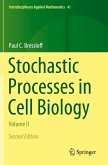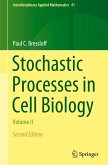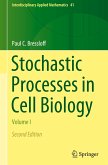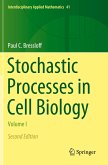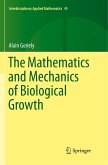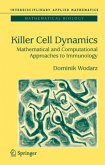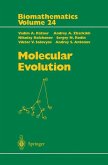This text is an introduction to dynamical modeling in cell biology. It is not meant as a complete overview of modeling or of particular models in cell biology. Rather, we use selected biological examples to motivate the concepts and techniques used in computational cell biology. This is done through a progression of increasingly more complex cellular functions modeled with increasingly complex mathematical and c- putational techniques. There are other excellent sources for material on mathematical cell biology, and so the focus here truly is computer modeling. This does not mean that there are no mathematical techniques introduced, because some of them are absolutely vital, but it does mean that much of the mathematics is explained in a more intuitive fashion, while we allow the computer to do most of the work. The target audience for this text is mathematically sophisticated cell biology or neuroscience students or mathematics students who wish to learn about modeling in cell biology. The ideal class would comprise both biology and applied math students, who might be encouraged to collaborate on exercises or class projects. We assume as little mathematical and biological background as we feel we can get away with, and we proceed fairly slowly. The techniques and approaches covered in the ?rst half of the book will form a basis for some elementary modeling or as a lead in to more advanced topics covered in the second half of the book.
"What better tribute to the late Joel Keizer than to expand his unfinished accounts of teaching and research to a splendid book. Computational Cell Biology performs much more than it promises, for it also deals with considerable analytical material and with aspects of molecular biology. There's something for everybody interested in how modeling leads to greater understanding in the core of the biological sciences." -Lee Segel (Weizmann Institute)
From the reviews:
Nature Cell Biology, Vol. 5/2, February 2003
"The authors and editors of this volume are outstanding mathematical biologists. Computational Cell Biology introduces the principles, techniques, tools and insights of mathematical biology through detailed exposition of ion channels, calcium signaling, transporters, cellular endocrinology, gap junctions, cell cycle controls and molecular motors. If you want to see the tools of applied mathematics at work in some key areas of cell physiology and cell biology, this is the book to read. Your understanding of rate laws, ordinary and partial differential equations, numerical methods, phase portraits, stability analysis, Brownian ratchets, multiple time scales, bifurcations and stochastic processes will all be enhanced. You will have become significantly bilingual. The authors reach out valiantly from the blue of mathematical biology toward the red of experimental biology. Perhaps the time has finally arrived when experimental cell biologists can reach back and shake hands on an effective partnership. It's an epochal moment; illuminating the shadowy complexity of cell biology will surely require white light."
BIOINFORMATICS
"...a very didactic, easy to read and excellent introduction to the subject...the book is remarkable for it pedagogical clarity...The book is strong in presenting the in-action techniques, with state-of-the art models of realistic biological situation, where their usefulness is easily appreciated. Another strength of the book is to provide examples of the comprehensive modeling, from the initial descriptive molecular model to the full analysis of the equations...Many modeling approaches presented in the book can be easily adapted or serve as templates to other biological problems...The mathematically-able should find [the book] a nice complement to the classical biology textbook...an attractive introduction to a number of mathematicaltechniques whose existence is simply unknown to many biologists. The remarkable clarity of the presentation makes it an unique self-teaching tool for scientists who would like to model their own experimental data, or to be able to appreciate modeling...a modern and valuable textbook full of simple yet useful analytical and numerical knowledge. It will please the mature scientist by its topics, and the student by its didactic style. Coming from a strong teaching practice, it is also the perfect support for a lecture series on mathematical modeling in biology."
"This textbook address students of either mathematics or the biological sciences interested in the other topic. It aims to introduce to computational cell biology, i.e. the question, whether and how mathematical modelling can contribute to a description or understanding of cellular phenomena. ... the book should be well readable and provide essential guide to the methodology of modelling in biology." (H. Muthsam, Monatshefte für Mathematik, Vol. 143 (4), 2004)
"Computational Cell Biology has been carefully designed as a text for an introductory course in cellular dynamics, in which the students are to be drawn from both biology and applied mathematics. ... Computational Cell Biology is an imaginatively conceived, carefully written, and well-edited book, which is strongly recommended as the text for advanced and early graduate courses in mathematical biology. Both students and teachers will enjoy learning from it, and future quantitative biologists and biomathematicians will remember it fondly." (Alwyn Scott, SIAM Review, Vol. 45 (2), 2003)
"Joel E. Keizer was the pioneer in computational cell biology. This textbook represents the combined efforts of friends and colleagues to complete a task that Joel was unable to ... end. In its pages one can easily sense the enthusiasm for this subject that he generated in others. It is a tribute that each chapter has been written by awell-recognized expert in the field. The result is a work that I believe should be on the desktop of all who appreciate good science." (John G. Milton, Mathematical Reviews, 2003 j)
"Computational Cell Biology is a recent introductory textbook for dynamic modelling in cell biology. ... The result is a very didactic, easy to read and excellent introduction to the subject. ... the book is remarkable for its pedagogical clarity. ... Another strength of the book is to provide examples of the comprehensive modelling ... . It will please the mature scientist by its topics, and the student by its didactic style. ... it is also the perfect support for a lecture series ... ." (Francois Nedelec, Bioinformatics, July, 2003)
"Computational Cell Biology presents us with some elegant presentation of fundamental topics. Many of the chapters are absolute gems. ... In short, Computational Cell Biology is a valuable addition to the literature, filling a number of gaps and presenting the material in a way that will be useful for students. It will have a place on my bookshelf, and in my required reading list." (James Sneyd, UK Nonlinear News, November, 2002)
Nature Cell Biology, Vol. 5/2, February 2003
"The authors and editors of this volume are outstanding mathematical biologists. Computational Cell Biology introduces the principles, techniques, tools and insights of mathematical biology through detailed exposition of ion channels, calcium signaling, transporters, cellular endocrinology, gap junctions, cell cycle controls and molecular motors. If you want to see the tools of applied mathematics at work in some key areas of cell physiology and cell biology, this is the book to read. Your understanding of rate laws, ordinary and partial differential equations, numerical methods, phase portraits, stability analysis, Brownian ratchets, multiple time scales, bifurcations and stochastic processes will all be enhanced. You will have become significantly bilingual. The authors reach out valiantly from the blue of mathematical biology toward the red of experimental biology. Perhaps the time has finally arrived when experimental cell biologists can reach back and shake hands on an effective partnership. It's an epochal moment; illuminating the shadowy complexity of cell biology will surely require white light."
BIOINFORMATICS
"...a very didactic, easy to read and excellent introduction to the subject...the book is remarkable for it pedagogical clarity...The book is strong in presenting the in-action techniques, with state-of-the art models of realistic biological situation, where their usefulness is easily appreciated. Another strength of the book is to provide examples of the comprehensive modeling, from the initial descriptive molecular model to the full analysis of the equations...Many modeling approaches presented in the book can be easily adapted or serve as templates to other biological problems...The mathematically-able should find [the book] a nice complement to the classical biology textbook...an attractive introduction to a number of mathematicaltechniques whose existence is simply unknown to many biologists. The remarkable clarity of the presentation makes it an unique self-teaching tool for scientists who would like to model their own experimental data, or to be able to appreciate modeling...a modern and valuable textbook full of simple yet useful analytical and numerical knowledge. It will please the mature scientist by its topics, and the student by its didactic style. Coming from a strong teaching practice, it is also the perfect support for a lecture series on mathematical modeling in biology."
"This textbook address students of either mathematics or the biological sciences interested in the other topic. It aims to introduce to computational cell biology, i.e. the question, whether and how mathematical modelling can contribute to a description or understanding of cellular phenomena. ... the book should be well readable and provide essential guide to the methodology of modelling in biology." (H. Muthsam, Monatshefte für Mathematik, Vol. 143 (4), 2004)
"Computational Cell Biology has been carefully designed as a text for an introductory course in cellular dynamics, in which the students are to be drawn from both biology and applied mathematics. ... Computational Cell Biology is an imaginatively conceived, carefully written, and well-edited book, which is strongly recommended as the text for advanced and early graduate courses in mathematical biology. Both students and teachers will enjoy learning from it, and future quantitative biologists and biomathematicians will remember it fondly." (Alwyn Scott, SIAM Review, Vol. 45 (2), 2003)
"Joel E. Keizer was the pioneer in computational cell biology. This textbook represents the combined efforts of friends and colleagues to complete a task that Joel was unable to ... end. In its pages one can easily sense the enthusiasm for this subject that he generated in others. It is a tribute that each chapter has been written by awell-recognized expert in the field. The result is a work that I believe should be on the desktop of all who appreciate good science." (John G. Milton, Mathematical Reviews, 2003 j)
"Computational Cell Biology is a recent introductory textbook for dynamic modelling in cell biology. ... The result is a very didactic, easy to read and excellent introduction to the subject. ... the book is remarkable for its pedagogical clarity. ... Another strength of the book is to provide examples of the comprehensive modelling ... . It will please the mature scientist by its topics, and the student by its didactic style. ... it is also the perfect support for a lecture series ... ." (Francois Nedelec, Bioinformatics, July, 2003)
"Computational Cell Biology presents us with some elegant presentation of fundamental topics. Many of the chapters are absolute gems. ... In short, Computational Cell Biology is a valuable addition to the literature, filling a number of gaps and presenting the material in a way that will be useful for students. It will have a place on my bookshelf, and in my required reading list." (James Sneyd, UK Nonlinear News, November, 2002)


